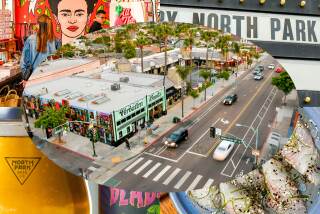Museum Recalls Era When It Was Chic to Be Named Canoga Park
- Share via
Mary Logan Orcutt thought the name of her West San Fernando Valley community was “cumbersome and unpleasing, both in sound and suggestion.” So she offered a “short, euphonious and distinctive” moniker, and it stuck.
No, the late Orcutt did not suggest West Hills. The year was 1929, when Canoga Park was known as Owensmouth.
The town has changed in many other ways since, and the Canoga Park Museum of History, which will open with ceremony today, will provide a look back in pictures, documents and other mementos.
The opening of the museum in the Canoga Park Community Center on Owensmouth Avenue coincides with the 75th anniversary of the community’s founding, said Beth Shirley, who is organizing the museum effort for the Canoga Park Women’s Club. It also comes at a time when Canoga Park is embroiled in a controversy about the adoption of the name West Hills by some who want to split away from the community.
The museum’s collection consists mostly of old photographs, assorted documents, placards and writings, including that of Orcutt, who was an active member of the women’s club in the 1920s and 1930s. Most of the museum’s items will be displayed in a large case in a front room of the community center.
The spot that now is Canoga Park originally was a railroad stop called Canoga, believed to be an Indian word meaning “watering hole.” When a town sprang to life there in 1912, it was named Owensmouth because it was among the first three communities established in the Valley with the completion of the Owens Valley Aqueduct, which brought water to the area.
The other towns were Van Nuys and Reseda, which was then called Marian. Owensmouth became Canoga Park in 1931, two years after Orcutt lobbied for the change with people as highly placed as President Herbert Hoover.
“Park” was added because, “at that particular era, that was sort of a classy name,” Shirley said.
The museum’s Nov. 15, 1918, copy of the Owensmouth Gazette, formerly the town’s weekly newspaper, provides a glimpse at the small-town past that is part of Canoga Park’s heritage.
“W. H. Paull is building a hay barn,” the paper reported. “Mrs. Gallow was in Tropico last Wednesday. . . . R. S. Cover of Needles, Calif., was the guest of his sister, Mrs. Lindsey, a few days last week. He says the ‘flu’ is over in Needles.”
The museum also has several early yearbooks from Owensmouth High School, which later became Canoga Park High School. In 1916, “The Utopian” yearbook printed photographs of the school’s first graduates--both of them.
The museum’s photographs remind John Pughe, 41, a lifelong Canoga Park resident, of his youth in the 1950s, when sheep and cows could be seen treading across Vanowen Street.
“I’m not one to live in the past, but the feeling was good, and the people were trusting,” said Pughe, a past president of the Canoga Park chapter of the Kiwanis Club.
The last movie Pughe saw in the town’s old theater was “The Wizard of Oz,” he said. Now the building houses a pornographic theater advertising “WANTON SEX” on its marquee.
The idea for a museum started three years ago when the Canoga Park Chamber of Commerce was making plans for the community center in an old restored firehouse, Shirley said.
Ceremony Today
The women’s club is sponsoring the museum temporarily and hopes to launch a historical society that can take over its operations, Shirley said. The museum is to be open from 2 to 4 p.m. today and on the second Sunday of each successive month, or by appointment, she said.
Today’s ceremony is to begin at 2:30 p.m. with a dedication by former Canoga Park Chamber of Commerce President Howard Speer and other local dignitaries.
It is the first such museum in Canoga Park. Catherine Mulholland, a local historian and granddaughter of the engineer of the Owens Valley Aqueduct, said she’s not sure why.
“The town has been very careless of its past,” said Mulholland, author of a book on West Valley history being released this month. “Perhaps it’s attributable to the terrific growth and radical change from a small agricultural market town to a great suburban community with so many newcomers.”
Mulholland was inspired to write her book, “The Owensmouth Baby,” about 10 years ago. She became “aghast and angered,” she said, to learn then that the last owner of the Canoga Park Herald, formerly the Owensmouth Gazette, had disposed of nearly all the paper’s back issues for more office space shortly before the paper closed in the early 1960s.
Shirley said the women’s club is continuing to seek donations of money and historical items, which have been somewhat hard to find, partly because of the area’s rapid growth and change.
“The other thing is, everybody who came here 75 years ago is dead,” she added.
More to Read
Sign up for Essential California
The most important California stories and recommendations in your inbox every morning.
You may occasionally receive promotional content from the Los Angeles Times.













